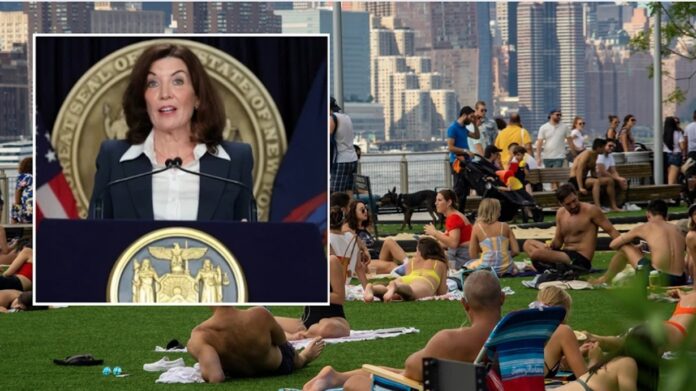- Governor Kathy Hochul declares a state of emergency for NYC ahead of a record-breaking heatwave expected to reach 102°F.
- Emergency resources, including cooling centers and extra personnel, are mobilized to protect vulnerable residents.
- The heatwave breaks a 125-year-old record, raising concerns about public health, infrastructure strain, and climate resilience.
As New York City braces for an unprecedented heatwave, Governor Kathy Hochul has taken swift action by declaring a state of emergency for the entire city. This bold move comes ahead of a predicted scorching heatwave. It could push temperatures to a sweltering 102 degrees, breaking records that have stood for more than 125 years.
The forecast paints a grim picture for residents, with Monday’s heat expected to climb close to 100 degrees. Tuesday could potentially top out at a blistering 102 degrees. The previous record in Central Park, set back in 1888 at 96 degrees, is set to be shattered. This sparks concerns over public health and safety across the city.
Governor Hochul Acts to Protect New Yorkers from Historic Heatwave
Governor Hochul’s emergency declaration unlocks vital resources to help the city cope with the extreme conditions. Cooling centers are being prepped, and extra emergency personnel have been deployed to support vulnerable communities. These include the elderly, young children, and those without access to air conditioning. Power companies are on high alert, working to prevent outages as the city’s energy demands surge.
“This heatwave is not just uncomfortable—it’s dangerous,” Hochul warned in a statement. “We’re mobilizing every available resource to protect New Yorkers and help them stay safe during these record-breaking temperatures.” The state of emergency also allows for faster response times. It allows the allocation of additional funding to hospitals and first responders facing an influx of heat-related illnesses.
Temperatures Expected to Smash 125-Year-Old Records in NYC
The extreme heat is not just about numbers on a thermometer. The intense humidity combined with soaring temperatures will create an oppressive environment. This significantly raises the risk of heat exhaustion and heat stroke. Emergency rooms across the city are preparing for a surge in patients suffering from heat-related ailments. This is a concern that public health officials take very seriously.
Meteorologists warn this heatwave is part of a larger pattern of increasing temperature extremes linked to climate change. The city’s infrastructure, much of it aging, will be tested like never before. Energy grids strain under the pressure of air conditioning demand. Public transit systems face heat-induced delays and disruptions.
Emergency Resources Mobilized to Support Vulnerable Communities
In response, the city has ramped up efforts to open and staff cooling centers in neighborhoods where residents are most at risk. Volunteers and social workers are coordinating outreach to check on seniors, people with medical conditions, and low-income families who may lack adequate cooling at home.
Public service announcements are running around the clock. They urge New Yorkers to drink plenty of water, avoid outdoor activities during peak heat hours, and to look out for signs of heat-related distress in themselves and others. The city is also encouraging residents to create “buddy systems” to ensure no one suffers alone during these extreme conditions.
Officials Warn Residents to Stay Safe Amid Sweltering Conditions
Despite these precautions, concerns remain over the city’s preparedness. New Yorkers remember all too well the devastating 2006 heatwave that claimed over 100 lives. Many worry that without significant investments in infrastructure and emergency planning, similar tragedies could occur.
City officials continue to emphasize personal responsibility but acknowledge the limits of individual action without systemic support. The state of emergency declaration aims to bridge that gap by fast-tracking resources where they are needed most.
Public Voices Concern Over City’s Preparedness for Extreme Heat
Social media channels have been flooded with mixed reactions. Some praise the governor’s quick response, while others express anxiety and frustration over the challenges ahead. Many worry about vulnerable neighbors, especially in areas known as “heat islands,” where concrete and asphalt trap more heat and shade is scarce.
Community leaders are calling for more long-term solutions. These include expanded tree planting programs, better cooling infrastructure, and improved energy efficiency to reduce the city’s overall heat burden.




